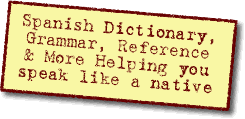Quote:
Originally Posted by AlwaysLost

So for instance: It is 6:00 p.m. sharp! is listed as Son las seis en punto!
|
It's all about the context. If you're talking to someone about what time it is now, you don't need to say if it's p.m. or a.m., as the other person already knows.
-- Disculpe, ¿me puede decir qué horas son? (Excuse me, would you tell me what time is it?)
-- Son las siete y cuarto. (It's a quarter past seven.) -> I'm talking about now, so the other person knows if it's a.m. or p.m.
- ¡Ya son las cinco y media, se me hizo tarde otra vez!
(It's five and a half, I'm late again!) -> Same as previous.
- Quiero que regreses a la una en punto o no te vuelvo a dar permiso de ir a una fiesta.
(I want you to be back here at one o'clock or I won't allow you to go to a party again.) -> Parties where parents are worried about the time their children come back home are usually at night, so no need to state whether it's a.m. or p.m.
But if the context is not enough, you always clarify:
--¿A qué hora es la reunión? (At what time is the meeting?)
--Es a las siete de la mañana en punto. (It's at seven a.m. sharp.)
-Voy a regresar a las diez y media de la noche.
(I'll be back at half past ten p.m.)
- Llámame al cuarto para las once de la noche para asegurarte de que estoy despierto.
(Call me at a quarter to eleven p.m. to make sure I'm awake.)
Quote:
Originally Posted by AlwaysLost

Edit: Also I see Es a eso de la una for About 1:00, and A eso de las dos de la tarde for About 2:00 p.m. Why is this?
|
In the case of "es a eso de la una", "es" is talking about the even that will happen at a time around one o'clock. The second example simply states the approximate hour for the event to happen.


 Similar Threads
Similar Threads







